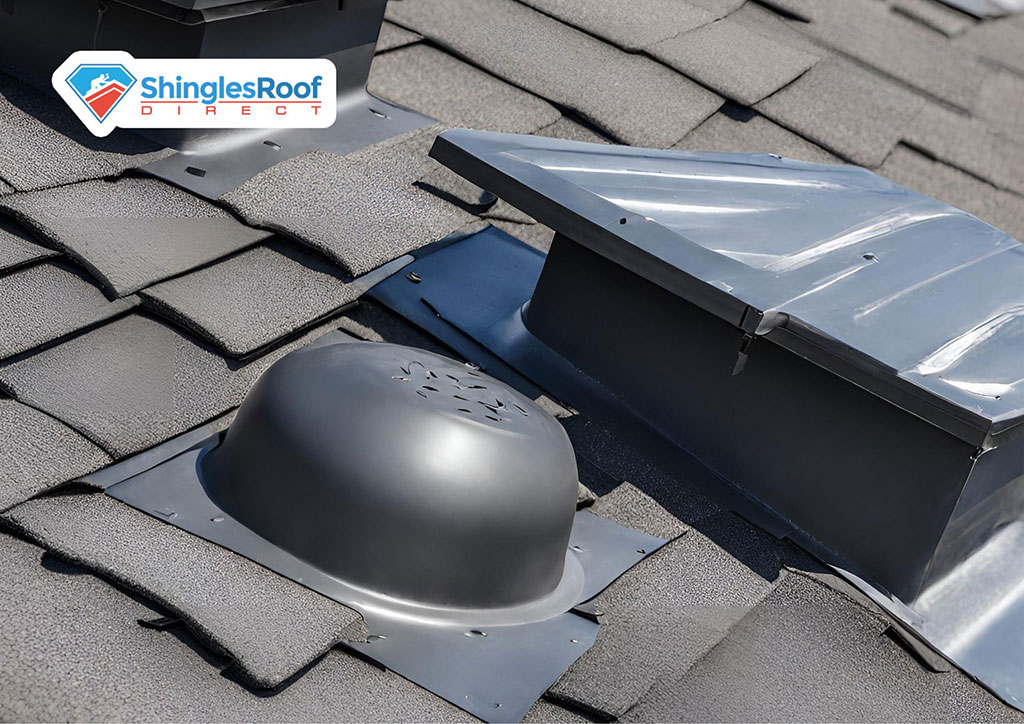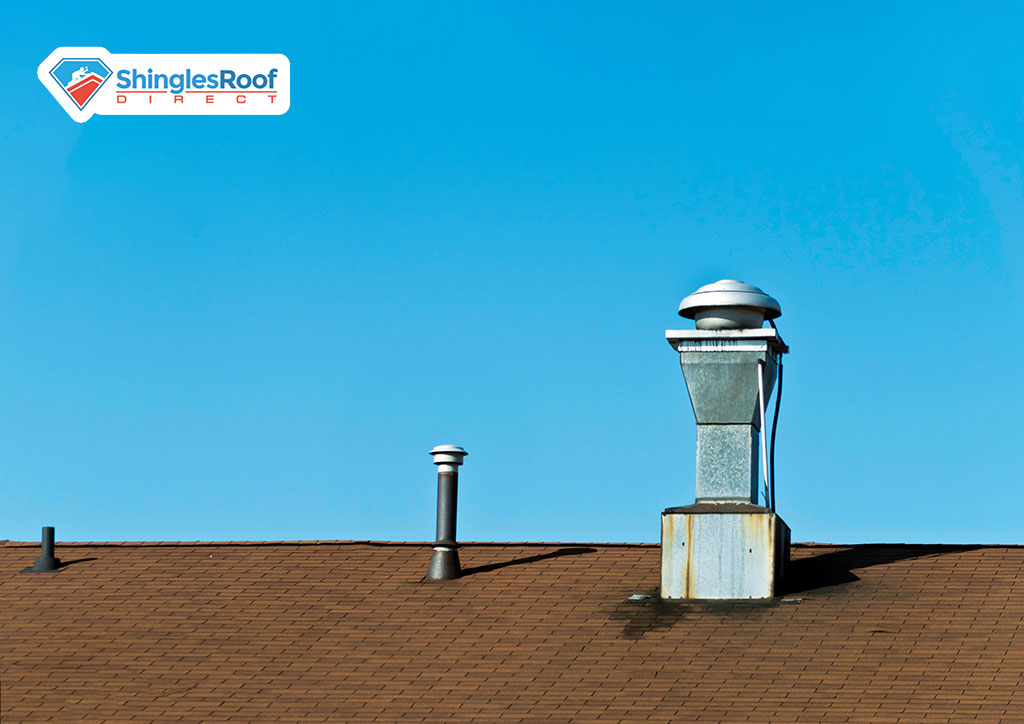Effective attic ventilation is essential for a strong roofing system. It plays a crucial role in regulating temperature, managing moisture levels, and safeguarding against problems such as mold, rot, and premature deterioration of shingles. While maintaining a balanced airflow through a well-coordinated system of intake and exhaust vent is important, the idea of mixing different types of exhaust vents, often perceived as a potential solution, may, in fact, present several complications that affect the attic’s airflow.
This article explores the significance of proper ventilation, the roles of intake and exhaust vents, and the risks associated with blending exhaust vent types in having a well-maintained and healthy roofing system.
Table of Contents
Understanding Different Exhaust Vent Types
Proper attic ventilation is essential for a healthy roofing system, and exhaust vents play a significant role. Each type of exhaust vent has unique characteristics and functionalities designed to expel hot, moist air from the attic, contributing to a balanced and efficient airflow system.
- Ridge Vents: Installed along the roof’s peak, running the entire length, allowing even release of warm air. They are discreet and effectively balance attic airflow.
- Box Vents: These square or rectangular vents near the roof’s top serve as exit points for hot air. They are simple in design and effective when properly installed.
- Turbine Vents: Using rotating parts, these vents harness the wind to create a suction effect that expels hot air. It is ideal for consistent wind areas, though efficiency may vary based on local climate.
- Power Vents: Motorized, these vents actively draw hot air out, triggered by a thermostat at specific attic temperatures. They work efficiently but consume electricity and may need regular maintenance.
The placement, size, and design of the roof determine the type of exhaust vent that would work best. The geographic location and climate should also be considered when selecting the most suitable exhaust vent for optimal performance and efficiency in attic ventilation.
Understanding the specific functionalities and proper installation of these exhaust vent types is vital to ensure that the attic ventilation system operates optimally, facilitating the expulsion of heat and moisture to maintain a healthy roof and living environment.
To understand more about the types of residential roof ventilation systems, we provided a guide, which you can find here, that delves deeper into the characteristics of roof vents and their impact on maintaining the integrity of your home’s roof.
The Importance of Balanced Ventilation
Attic ventilation plays an important role in preserving the structural integrity of a home’s roofing system. An imbalance in the ventilation system, such as an inadequate intake or mismatched exhaust vents, can result in restricted airflow, causing temperature differentials and moisture accumulation. These conditions can lead to severe problems like moisture-related damage, reduced insulation effectiveness, and a higher likelihood of mold, rot, and ice dam formation during colder seasons.
RELATED: Roofing Charlotte NC: 6 Tips You Need To Know During Winter
Intake vents are strategically positioned at the lower parts of the roof, often within the soffit or along the roof’s edge. These vents facilitate the inflow of fresh, cooler air from the exterior into the attic space. This influx of air helps to counteract the buildup of heat and moisture within the attic, thus maintaining a more stable and moderate internal temperature.
On the other hand, exhaust vents are located at or near the roof’s peak. Their primary function is to expel the warmer, moist air accumulated within the attic space. By exhausting this stale air to the outside, these vents aid in maintaining proper airflow and reducing humidity levels, preventing issues such as condensation and subsequent mold or rot formation.
Combining intake and exhaust vents is essential for maintaining an effective and efficient ventilation system. When balanced correctly, this system ensures continuous air exchange, preventing warm, moist air stagnation within the attic. This balance also helps preserve the roof’s structural integrity and contributes significantly to the home’s overall energy efficiency.
Problems in Mixing Exhaust Vent Types
Mixing different exhaust vent types might seem like a solution for improved ventilation, but the results can be severe.
1. Disturbed Airflow and Inefficient Ventilation
When various exhaust vent types are mixed within a roofing system, it disrupts the natural flow of attic air. The system’s airflow becomes inefficient as these different vents may not complement each other’s functionality. This disruption often leads to stagnant air pockets or inconsistent ventilation, compromising the system’s effectiveness.

2. Shortcircuiting the Ventilation System
Combining multiple exhaust vent types can create ‘shortcircuits’ within the ventilation system. These shortcircuits disrupt the intended airflow path, allowing for unintended air passages. This can lead to issues like weather infiltration, where elements such as rain, snow, or debris infiltrate the attic space. These shortcuts can also compromise the system’s efficiency, rendering it less effective in maintaining a balanced climate within the attic.
3. Mold, Rot, and Moisture Buildup
One of the most problematic outcomes of improper attic ventilation due to mixed exhaust vents is the potential for moisture buildup. When the airflow is disrupted or inefficient, moisture tends to accumulate. This excess moisture creates a conducive environment for mold and rot in the attic space and even affects the decking. The presence of mold poses health risks and deteriorates the roofing system’s structural integrity.
4. Premature Aging of Shingles
Inadequate ventilation resulting from mixing exhaust vents can cause shingles to age prematurely. Excessive heat and moisture can build up without proper ventilation, affecting the shingles’ integrity. This accelerated aging can cause them to become brittle, crack, or curl, significantly reducing their lifespan and effectiveness in protecting the roof.
Best Practices for Proper Ventilation
Implementing these best practices can significantly enhance the efficiency and longevity of your roofing system by ensuring proper attic ventilation and mitigating potential issues associated with mixing exhaust vent types.
1. Choosing the Correct Exhaust Vents
Opting for the right exhaust vents compatible with the roof’s specific size, architecture, and overall design is critical to ensuring proper ventilation. Factors such as the roof’s pitch, square footage, and structure are essential in determining the most suitable exhaust vent type. Installing exhaust vents that align with the roof’s characteristics maximizes their efficiency and effectiveness in expelling hot, moist air from the attic space. Additionally, seeking professional advice or consulting with roofing experts can aid in selecting the most appropriate exhaust vent for your specific roofing system.
2. Balanced Intake Ventilation
Achieving a perfect balance between intake and exhaust ventilation is crucial for optimizing the overall airflow within the attic space. Sufficient intake ventilation, typically positioned at the roof’s edges, eaves, or soffits, allows fresh air to enter the attic, facilitating a continuous and efficient airflow pattern. The quantity and placement of intake vents should correspond to the number and type of exhaust vents installed. This balanced system ensures a steady fresh air flow while effectively expelling stale, moisture-laden air. Properly aligned intake ventilation assists in preventing issues such as moisture accumulation, which can lead to mold, mildew, and structural damage within the roofing system.
3. Consideration of Climate and Environmental Factors
Tailoring the ventilation system to accommodate regional climate conditions is essential. Different climates demand specific ventilation approaches; for instance, regions with high humidity levels may require more focus on moisture control, while areas prone to heavy snowfall might necessitate precautions against ice dams. Understanding the environmental elements unique to your area enables the selection of ventilation systems that effectively combat potential issues, ensuring the durability and longevity of the roof.
4. Regular Maintenance and Inspection
Once the ventilation system is installed, consistent monitoring and maintenance are crucial for optimal performance. Periodic inspections help identify blockages, damage, or obstructions that may hinder the system’s functionality. Clearing debris, ensuring proper insulation, and promptly addressing any issues will contribute to the roofing system’s longevity and maintain the ventilation setup’s efficiency.
5. Consultation with Roofing Professionals
Seeking guidance from experienced roofing professionals can provide valuable insights and recommendations regarding the most suitable ventilation system for your specific roofing structure. These experts can offer tailored solutions, considering your roof’s characteristics and environmental factors, ensuring an effective and durable ventilation setup.
Why Mixing Exhaust Vents Is Not a Solution
Despite potential improvisation intentions, mixing exhaust vent types proves counterproductive in maintaining an optimally functioning roof ventilation system. While it might seem like a creative solution to enhance airflow and address specific concerns, experts consistently warn against this practice due to its far-reaching negative implications.
The underlying ventilation strategy primarily relies on a balanced system—achieving an equilibrium between intake and exhaust vents to promote efficient airflow throughout the attic space. The introduction of mixed exhaust vent types disturbs this balance. It interferes with the predetermined mechanisms to ensure adequate air circulation, thus impeding the natural and effective air movement within the roofing structure.

While mixing exhaust vents might initially seem like an innovative or cost-effective approach, the reality shows that it is not a viable solution. The repercussions of such actions can outweigh any perceived short-term benefits, ultimately leading to structural problems, higher maintenance costs, and a compromised roof lifespan. Experts strongly advocate for maintaining a uniform and compatible system, utilizing the correct exhaust vent types tailored to the roof’s design to ensure optimal and efficient ventilation without risking long-term complications.
Conclusion: Harmony in Ventilation
The integrity and longevity of a roofing system hinge significantly on a properly balanced and well-maintained ventilation network. The orchestration of intake and exhaust vents to ensure an efficient airflow system is vital for the roof’s health. The complications from mixing various exhaust vent types, such as disturbed airflow, compromised efficiency, and the potential for structural damages, underscore the critical necessity of ensuring compatibility and appropriateness in vent type selection.
The lessons drawn from industry expertise emphasize that while the temptation to mix exhaust vents may arise, it often creates more problems than solutions. The intricacies of roofing ventilation systems show the importance of adhering to best practices and utilizing vent types designed for specific roof structures to maintain a healthy and functional system.
The key takeaway is that while the importance of proper ventilation cannot be overstated, mixing different exhaust vent types is not a viable solution. It disrupts the delicate balance required for an efficient and effective roofing system.
Quick FAQs on Residential Roof Ventilation Systems
Can I mix different types of exhaust vents in my attic?
Mixing different exhaust vent types can disrupt the proper airflow in the attic, leading to inefficiencies and potential issues like mold, rot, and prematurely aging shingles. It’s generally not recommended as it can compromise the ventilation system’s effectiveness.
Why is balanced ventilation important for a healthy roof system?
Balanced ventilation ensures proper airflow, regulating heat and moisture to prevent issues like ice dams, mold, and premature aging of shingles. Intake vents bring in fresh air, while exhaust vents expel stale air, maintaining a healthy equilibrium in the attic.
What should I consider when choosing exhaust vents for my roof?
Selecting the correct exhaust vent that matches your roof’s size and design. Different vents have specific functionalities and are suitable for particular roof structures. It’s essential to ensure compatibility and proper installation to avoid issues related to mixing exhaust vent types.

